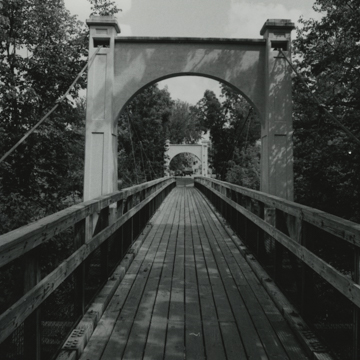City beautification was sometimes seen in the early twentieth century as a “domestic” cause, and for many women it was a means to exercise political power. Here at a picnic in 1900, local women formed the River Falls Improvement League to beautify two-year-old Glen Park. Over the next three decades, the league spearheaded campaigns to build bridges, a rustic stone lodge (now demolished), and a concert pavilion. By the mid-1920s, increased leisure time and rising automobile ownership placed ever-greater pressure on Glen Park’s facilities. Recognizing this problem, in 1925 the women’s group raised funds for this footbridge connecting Cascade Avenue with the park. Only 190 feet long, it is unusually short for a suspension bridge. The footbridge has a deck suspended from cables, which are draped over support towers and anchored in concrete abutments at each end. Here, the deck and railings are wooden. The concrete towers have arches linking paneled columns, topped with simple capitals.
Situated where the Kinnickinnic River and its South Fork cascade toward their confluence, tree-shaded Glen Park became a regional attraction in the early twentieth century, drawing excursionists from as far as Minneapolis. Waterfalls had also lured the town’s first settlers in the late 1840s, but those newcomers had valued the rivers more for their capability to drive sawmills and flour mills than for their scenery.









